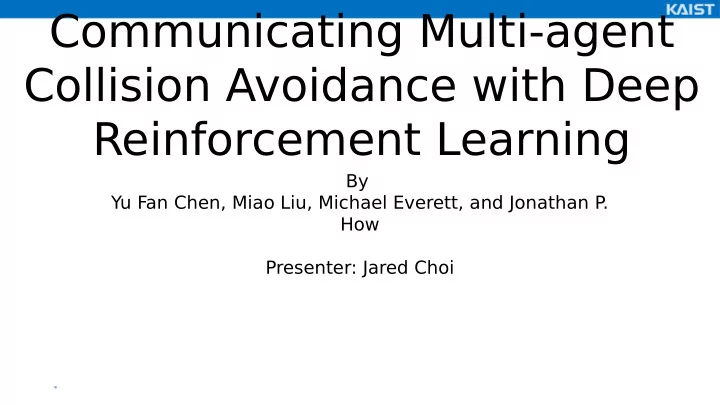

Decentralized Non- Communicating Multi-agent Collision Avoidance with Deep Reinforcement Learning By Yu Fan Chen, Miao Liu, Michael Everett, and Jonathan P . How Presenter: Jared Choi
Motivation • Finding a path • Computationally expensive due to • Collision checking • Feasibility checking • Effjciency checking
Motivation • Finding a path • Computationally expensive due to • Collision checking • Feasibility checking • Effjciency checking • Offmine Learning
Background • A sequential decision making problem can be formulated as a Markov Decision Process (MDP) • M = <S, A, P, R, >
Background • A sequential decision making problem can be formulated as a Markov Decision Process (MDP) • M = <S, A, P, R, > • S (state space) • A(action space) • P(state transition model) • R: reward function • : discount factor
State Space (M = < S , A, P, R, >) • S(state space) • System’s state is constructed by concatenating the two agents’ individual states Observable State Vector (position (x,y), velocity(x,y), radius) Unobservable State vector (goal position (x,y), preferred speed, he
State Space (M = < S , A, P, R, >) • S(state space) • System’s state is constructed by concatenating the two agents’ individual states Observable State Vector (position (x,y), velocity(x,y), radius) Unobservable State vector (goal position (x,y), preferred speed, hea
Action Space (M = <S, A , P, R, >) • A(action space): • Set of permissible velocity vectors, a(s) = v
State Transition Model(M = <S, A, P , R, >) • P(state transition model) • A probabilistic state transition model • Determined by the agents’ kinematics • Unknown to us
Reward Function (M = <S, A, P, R , >) • R: reward function • Award the agent for reaching its goal • Penalize the agent for getting too close or colliding with other agent
Discount Factor(M = <S, A, P, R, >) • Discount factor
Value Function • The value of a state • Value depends on • close to 1 • We care about our long term reward • close to 0 • We care only about our immediate reward
Optimal Policy • The best trajectory at given state
Value Function and Optimal Policy From David Silver’s slide
Value Function and Optimal Policy • Every state s has value V(s) • Store it in a lookup table • In a grid world : 16 values • In motion planning : Infjnite values (b/c it’s continuous state space) • Solution: • Approximate value via neural network
Value Function and Optimal Policy From David Silver’s slides
Value Function and Optimal Policy
Collision Avoidance Deep Reinforcement Learning 1.T rain Value network using ORCA 2.T rain again with Deep reinforcement Learning
Collision Avoidance Deep Reinforcement Learning 1.T rain Value network using ORCA • Why pre-train?
Collision Avoidance Deep Reinforcement Learning 1.T rain Value network using ORCA • Why pre-train? - Initializing the neural network is crucial to convergence - We want the network to output something reasonable
Collision Avoidance Deep Reinforcement Learning 1.T rain Value network using ORCA • Why pre-train? - Initializing the neural network is crucial to convergence - We want the network to output something reasonable • Generate 500 trajectories as a training set • Each trajectory contains 40 state-value pairs (total of 20,000 pairs) • Back-propagate to minimize our loss function:
Collision Avoidance Deep Reinforcement Learning 1.T rain Value network using ORCA 2.T rain again with Deep reinforcement Learning
Collision Avoidance Deep Reinforcement Learning 1.T rain again with Deep reinforcement Learning
Collision Avoidance Deep Reinforcement Learning 1.T rain again with Deep reinforcement Learning
Collision Avoidance Deep Reinforcement Learning 1.T rain again with Deep reinforcement Learning
Collision Avoidance Deep Reinforcement Learning 1.T rain again with Deep reinforcement Learning
Collision Avoidance Deep Reinforcement Learning 1.T rain again with Deep reinforcement Learning
Collision Avoidance Deep Reinforcement Learning 1.T rain again with Deep reinforcement Learning
Collision Avoidance Deep Reinforcement Learning 1.T rain again with Deep reinforcement Learning
Collision Avoidance Deep Reinforcement Learning 1.T rain again with Deep reinforcement Learning
Collision Avoidance Deep Reinforcement Learning 1.T rain again with Deep reinforcement Learning
Collision Avoidance Deep Reinforcement Learning 1.T rain again with Deep reinforcement Learning
Collision Avoidance Deep Reinforcement Learning 1.T rain again with Deep reinforcement Learning
Collision Avoidance Deep Reinforcement Learning 1.T rain again with Deep reinforcement Learning
Collision Avoidance Deep Reinforcement Learning 1.T rain again with Deep reinforcement Learning
Collision Avoidance Deep Reinforcement Learning 1.T rain again with Deep reinforcement Learning
Collision Avoidance Deep Reinforcement Learning 1.T rain again with Deep reinforcement Learning
Collision Avoidance Deep Reinforcement Learning 1.T rain again with Deep reinforcement Learning Backpropagatio n
Collision Avoidance Deep Reinforcement Learning 1.T rain again with Deep reinforcement Learning
Result
Result
Result
Q&A
Quiz Values are update after each episode (T/F) Value function needs to be trained with ORCA (T/F) ORCA path does not need to be optimal (T/F)
Recommend
More recommend